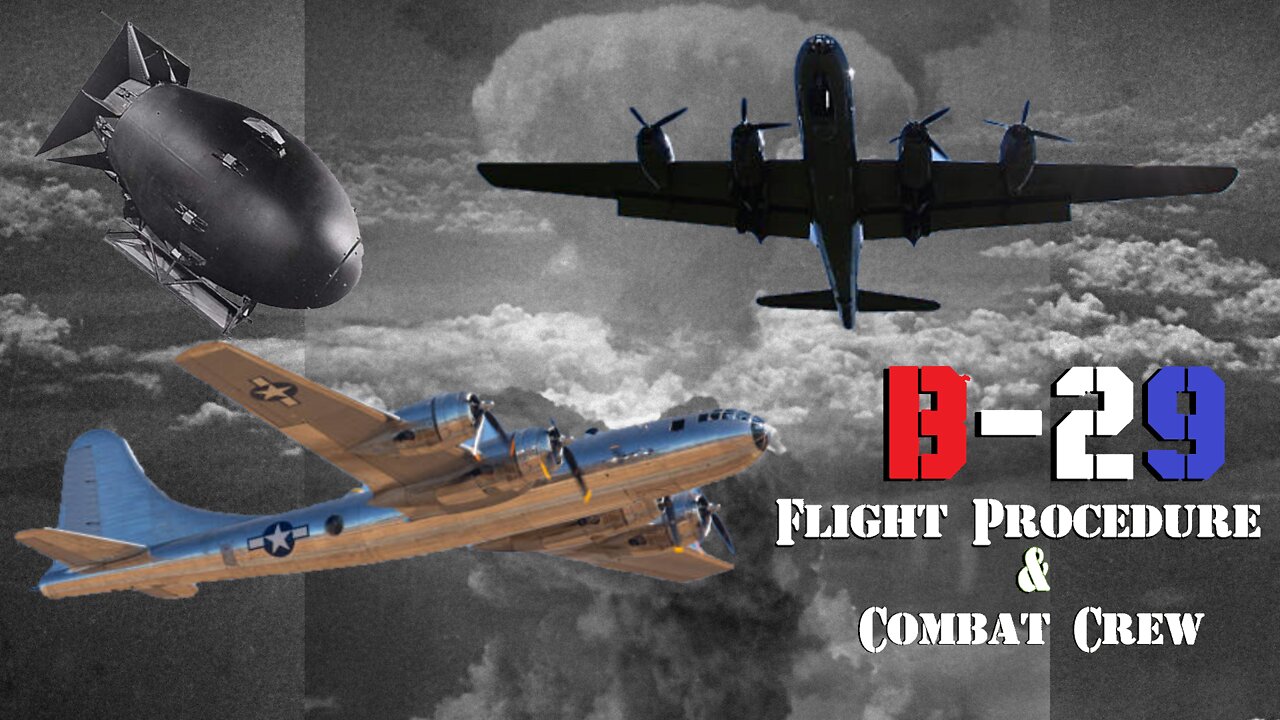Premium Only Content

Boeing B-29 Superfortress
We are a Public Domain sharing community,with a focus on American life pre-1970's..
These videos are for Historic and Cultural preservation. See something interesting?
We encourage viewers to add comments and, especially, to provide additional
information about our videos by adding a comment!
The Boeing B-29 Superfortress is an American four-engined propeller-driven heavy bomber, designed by Boeing and flown primarily by the United States during World War II and the Korean War. Named in allusion to its predecessor, the B-17 Flying Fortress, the Superfortress was designed for high-altitude strategic bombing, but also excelled in low-altitude night incendiary bombing, and in dropping naval mines to blockade Japan. B-29s dropped the atomic bombs on Hiroshima and Nagasaki, the only aircraft ever to drop nuclear weapons in combat.
One of the largest aircraft of World War II, the B-29 was designed with state-of-the-art technology, which included a pressurized cabin, dual-wheeled tricycle landing gear, and an analog computer-controlled fire-control system that allowed one gunner and a fire-control officer to direct four remote machine gun turrets. The $3 billion cost of design and production (equivalent to $45 billion today),[3] far exceeding the $1.9 billion cost of the Manhattan Project, made the B-29 program the most expensive of the war.[4][5] The B-29's advanced design allowed it to remain in service in various roles throughout the 1950s. The type was retired in the early 1960s, after 3,970 of them had been built. A few were also used as flying television transmitters by the Stratovision company. The Royal Air Force flew the B-29 as the Washington until 1954.
The B-29 was the progenitor of a series of Boeing-built bombers, transports, tankers, reconnaissance aircraft, and trainers. For example, the re-engined B-50 Superfortress Lucky Lady II became the first aircraft to fly around the world non-stop, during a 94-hour flight in 1949. The Boeing C-97 Stratofreighter airlifter, which was first flown in 1944, was followed in 1947 by its commercial airliner variant, the Boeing Model 377 Stratocruiser. This bomber-to-airliner derivation was similar to the B-17/Model 307 evolution. In 1948, Boeing introduced the KB-29 tanker, followed in 1950 by the Model 377-derivative KC-97. A line of outsized-cargo variants of the Stratocruiser is the Guppy / Mini Guppy / Super Guppy, which remain in service with NASA and other operators. The Soviet Union produced 847 Tupolev Tu-4s, an unlicensed reverse-engineered copy of the B-29. Twenty B-29s remain as static displays, but only two, FIFI and Doc, still fly.
American Media Ephemera
Truth Social
@AmericanMediaEphemera
#ephemera #educational #culture #knowledge #news
#lifestyle #makesocialmediafunagain #Aviation #flying #warplane #truth
#socialguidance #Religion #conservative #rights #combat #airplane #training
#Republican #DIY #elections #miltary #guns
-
 18:38
18:38
VSiNLive
1 day agoProfessional Gambler Steve Fezzik LOVES this UNDERVALUED Point Spread!
90K11 -
 LIVE
LIVE
Right Side Broadcasting Network
10 days agoLIVE REPLAY: President Donald J. Trump Keynotes TPUSA’s AmFest 2024 Conference - 12/22/24
6,149 watching -
 4:31
4:31
CoachTY
20 hours ago $19.28 earnedCOINBASE AND DESCI !!!!
97.8K8 -
 10:02
10:02
MichaelBisping
19 hours agoBISPING: "Was FURY ROBBED?!" | Oleksandr Usyk vs Tyson Fury 2 INSTANT REACTION
47.2K8 -
 8:08
8:08
Guns & Gadgets 2nd Amendment News
2 days ago16 States Join Forces To Sue Firearm Manufacturers Out of Business - 1st Target = GLOCK
84.5K74 -
 10:17
10:17
Dermatologist Dr. Dustin Portela
2 days ago $17.24 earnedOlay Cleansing Melts: Dermatologist's Honest Review
127K10 -
 1:02:20
1:02:20
Trumpet Daily
2 days ago $39.71 earnedObama’s Fake World Comes Crashing Down - Trumpet Daily | Dec. 20, 2024
85.1K57 -
 6:29
6:29
BIG NEM
1 day agoCultivating God Mode: Ancient Taoist NoFap Practices
63.2K9 -
 30:53
30:53
Uncommon Sense In Current Times
2 days ago $10.66 earned"Pardon or Peril? How Biden’s Clemency Actions Could Backfire"
77.9K5 -
 40:01
40:01
CarlCrusher
1 day agoSkinwalker Encounters in the Haunted Canyons of Magic Mesa - ep 4
72.4K5